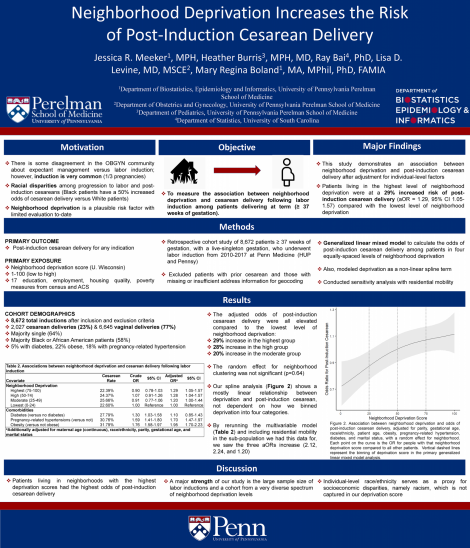Jessica Meeker
Neighborhood Deprivation Increases the Risk of Post-Induction Cesarean Delivery.
Abstract
The objective of this study was to measure the association between neighborhood deprivation and post-induction cesarean delivery. We conducted a retrospective cohort study of patients ≥ 37 weeks of gestation, with a live, singleton gestation, who underwent labor induction from 2010-2017 at Penn Medicine. We excluded patients with a prior cesarean delivery and those with missing or insufficient address information for geocoding purposes. Our primary exposure was neighborhood deprivation, for which we used the University of Wisconsin’s Area Deprivation Index (ADI). This national ADI score includes 17 indicators of deprivation including poverty and education, and ranges from 1-100 (least to most deprived). We used a generalized linear mixed model to calculate the odds of post-induction cesarean delivery among patients in 4 equally-spaced levels of neighborhood deprivation (ADI scores of 0-24; 25-49; 50-74; 75-100). Our cohort contained 8,672 patients receiving an induction at Penn Medicine and having complete information for confounder adjustment. After adjustment for confounders including patient age, race/ethnicity, parity, marital status, gestational age, pregnancy-related hypertension, diabetes, and maternal obesity, we found that patients living in the highest-level of neighborhood-deprivation were at a 29% increased risk of post-induction cesarean delivery (aOR=1.29, 95% CI 1.05-1.57) compared to the lowest level of neighborhood deprivation. In conclusion, patients living in neighborhoods with higher levels of deprivation had higher odds of post-induction cesarean delivery compared to patients living in less deprived neighborhoods. This work represents an important first step in understanding the impact of disadvantaged neighborhoods on adverse delivery outcomes.
Keywords
maternal health, severe maternal morbidity, reproductive epidemiology, spatial modeling, neighborhood deprivationCommenting is now closed.
About Us
To understand health and disease today, we need new thinking and novel science —the kind we create when multiple disciplines work together from the ground up. That is why this department has put forward a bold vision in population-health science: a single academic home for biostatistics, epidemiology and informatics.
© 2023 Trustees of the University of Pennsylvania. All rights reserved.. | Disclaimer




Comments